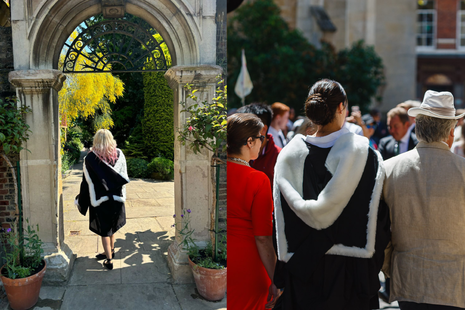Is Cambridge’s graduation dress code outdated?
After a summer of graduations, Ava Connors reflects on Cambridge’s academic dress codes

Few traditions evoke the spirit of Cambridge like academic dress: the centuries-old practice that marks a student’s progression from matriculation to graduation. Graduates donning the iconic fur hoods outside Senate House are classically Cambridge. This academic dress is a large part of what connects the past to the present in the university. Given the nickname “gownies” for students, the use of gowns at formal and professors wearing them to conduct exams, it’s safe to say academic wear still holds a firm grip on the establishment. Despite the reverence for tradition, the strict dress code for graduation is facing growing objections among students who feel the rules are outdated and restrict self-expression — with some students comparing it to the rigidity of a school uniform. The dress code fails to cater to the needs of all students, being particularly challenging for female and non-binary students.
“There is an implicit understanding that the female body is to be seen as a distraction during the prestigious occasion”
At the core of this discontent is how students are limited to only two options — a suit with a white bow-tie and bands or a skirt/trouser suit with or without a white bow-tie and bands. Jewellery and hair accessories “should not be conspicuous and should befit the occasion”. Some colleges have additional rules, like Pembroke, which states that there must be “no bare arms or legs” and “Dresses and skirts must be knee length or longer”. In the case of “inappropriate” attire, the student cannot proceed to their degree. In many colleges, deciding if a student is dressed appropriately enough to graduate is up to the discretion of the Praelector. This discretion is especially contentious when it comes to female students, as such practices can act as a mechanism for policing bodies.
For many students, the length rule may bring memories of being told to wear longer skirts in school as they were a supposed distraction to boys and male teachers. There is an implicit understanding that the female body is to be seen as a distraction during the prestigious occasion. Recent years have seen greater resistance to and awareness around school dress codes that unfairly target and shame the female body. Demanding that young girls “cover up” reinforces the misconception that the female body is the problem in the case of sexual harassment. This was apparent when academic dress was first made for female students, after finally accepting women into Cambridge. When Newnham first introduced a gown for female students in 1947, it was purposely tailored to be different from the male gown. The usual slits in the sleeves were sewn up to prevent the exhibition of bare arms for women wearing short sleeve dresses. This enforced covering of the body frames girls and women as “space invaders” in academia — they must be covered up otherwise they do not belong in places of education.
“Rules surrounding dress have historically been imposed to establish order and hierarchy; undeniably, appearance and clothing has and continues to be linked to social status”
Globally, dress codes have sparked controversy for stifling the creativity and self-expression that fashion affords. Within workplaces, rules surrounding dress have historically been imposed to establish order and hierarchy; undeniably, appearance and clothing has and continues to be linked to social status (just as Cambridge’s academic dress symbolises an individual’s privileged status as a student). Graduating students, as part of their celebration, often desire to create outfits that reflect and commemorate their sense of style.
For some members of the university, however, the dress code represents an important link to the past. After all, students were required to wear gowns after dusk until 1963. Like gown-wearing, certain aspects of the university are intrinsically and uniquely “Cambridge” (matriculation, Bridgemas, and the use of Latin, to name a few). These traditions carry historical value as centuries-old practices, allowing students to become part of something bigger than themselves. Tradition is part of “what makes Cambridge, Cambridge”, and these dress codes cement ourselves within these traditions.
Underlying the dress code is the university’s likely fear that relaxing the rules would cause students to go “wild”, however most other universities offer a dress code where students can express themselves but still stay sufficiently formal for the occasion. Where as Cambridge students are often required to purchase expensive pieces they will only wear once, creating potentially visible class and economic divides, as wealthier students may be able to splash out for custom attire while others may choose to rent second-hand items.
Another option for graduation is a formal dress, or suit in any colour or style, much like other universities while retaining some traditions like the fur hoods, to respect the continuity of Cambridge’s heritage. By providing some flexibility, the University would acknowledge and support the diverse desires of the student body; in promoting freedom of expression but still maintaining the much-valued tradition of academic dress.
 News / Caius mourns its tree-mendous loss23 December 2025
News / Caius mourns its tree-mendous loss23 December 2025 News / Clare Hall spent over £500k opposing busway 24 December 2025
News / Clare Hall spent over £500k opposing busway 24 December 2025 Comment / Yes, I’m brown – but I have more important things to say22 December 2025
Comment / Yes, I’m brown – but I have more important things to say22 December 2025 Comment / The ‘class’ of Cambridge24 December 2025
Comment / The ‘class’ of Cambridge24 December 2025 Interviews / Politics, your own way: Tilly Middlehurst on speaking out21 December 2025
Interviews / Politics, your own way: Tilly Middlehurst on speaking out21 December 2025








